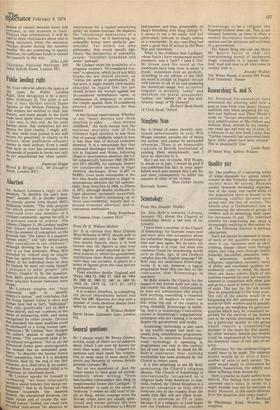Abortion
Sir: Robert Lindsay's reply to the question: "Is abortion the law's business?" January 19, is slender indeed. He merely quotes John Stuart Mill's utilitarian maxim, "The only purpose for which power can be rightfully exercised over any member of a civilised community, against his will, is to prevent harm to others" (On Liberty, Chapter 1). Mr Lindsay implies that 'others' include human foetuses, from the moment of conception, on the grounds that "the foetus is a separate human entity," and "any demarcation after conception is too arbitrary," although drawing the line at conception is no less arbitrary. What Mill Intended by 'others' may be clearer from his better-known dictum, "The liberty of the individual must be thus far limited; he must not make himself a nuisance to other people" (On Liberty, Chapter 3). So the question, from Mill's point-of-view, would have ueen whether human foetuses were People.
Mr Lindsay singles out "four
inferential aids to identify embryo's status," and concludes that the living human foetus is alive and human (not bad so far!), "individual" (but only genetically: not in Mill's sense above), and not a person, in the sense of interacting with, and being recognised by other people. (Notice that precisely the same qualities could he attributed to a living human sperMatozoon.) Mr Lindsay then changes the subject, appeals to papal dogma, and avers: "The unwanted child is being refused recognition." Not at all: the 11„nwanted foetus goes unrecognised; Lne woman has an unwanted pregparley. To describe the human foetus rtirri conception, even if it is drinking amniotic fluid by the end,,, of the first trimester, as a child (that iA, an actual, as distinct from a potential child) is to Perpetrate an emotional deceit. Mr Lindsay speaks for himself in e°nfessing: "we must reluctantly sacrifice moral honesty (to) moral resractability," that is, in favour of "the ,rassed housewife, the deserted "udent, the abandoned divorcee, the rapist victim and of course the mal'erined foetus." Indeed, one could view 8°-Calied 'indications' for abortion as instructions for a capital sentencing policy on human foetuses. He deplores the "intentional destruction of a healthy foetus," as if destroying an unhealthy foetus were perfectly permissible. Yet within his own philosophy, that would equally legitimate the destruction of unhealthy people: "Goodbye Granddad and amen" perhaps?
Mr Lindsay raises the possibility of a pregnant woman's "ill-considered consent" to abortion, which he (if not Mill) thinks the law should prevent, as "within the ambit of paternalism." At this level, it might equally (and equally absurdly) be .argued that the law should protect the woman against her ill-considered embarkation upon, or continuation of, pregnancy; or protect the couple against their ill-considered practice of contraception, for that matter.
A few factual observations. Whether or not "many doctors now think abortion is safer . . . than normal childbirth," the facts remain that the maternal mortality risk of first trimester legal abortion is less than that of normal childbirth, which in turn is less than that of second trimester abortion. It is a remarkable fact that estimated discharges from NHS hospitals in England and Wales, following illegal or spontaneous abortion, did not fall substantially between 1968 (69,393) and 1971 (65,009), for example, despite the considerable increase in legal abortion discharges (from 21,507 to 59,695). Even more remarkable is the fact that deaths attributed to illegal or spontaneous abortion did fall substantially, from forty-five in 1968, to fifteen in 1971; although deaths attributed to legal abortion increased meanwhile from five to twelve (including up to three non-residents), mainly due to second trimester abortion, and/or concurrent sterilisation.
Philip Kestelman 10 Carston Close, London SE12-
From Dr R. Willson-Hallett Sir: It is curious that Miss Elspeth Rhys-Williams of SPUC should seek to draw attention only to the 1967 abortion deaths figures, since it is well known that the figures in that year were slightly under-reported for technical reasons to which the government statisticians have drawn attention on more than one occasion. A glance at a series of figures gives the total picture in perspective:
Total abortion deaths: England and Wales 1962-72. 1962 57; 1963 49; 1964 50; 1965 52; 1966 53; 1967 34; 1968 50; 1969 35; 1970 32; 1971 27; 1972 '(provisional) 23.
It is evident; therefore, in comparing the period immediately before and after the 1967 Abortion Act that over a number of years abortion deaths have fallen by more than half.
R. Willson-Hallett Barrie House, Lancaster Gate, London W2


































 Previous page
Previous page